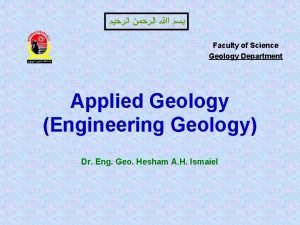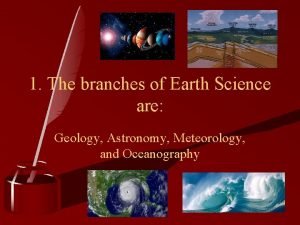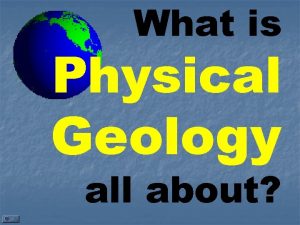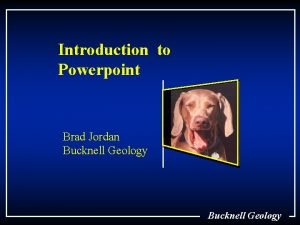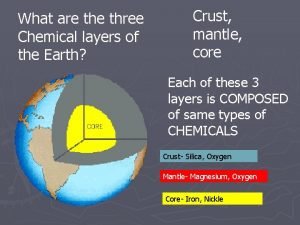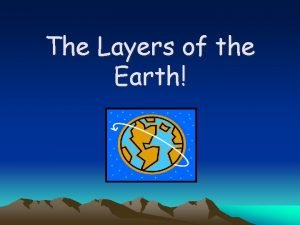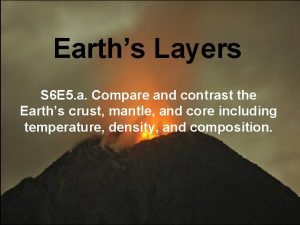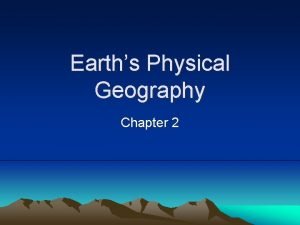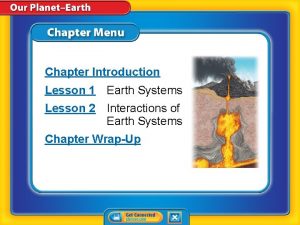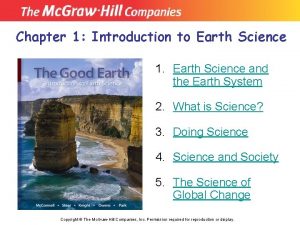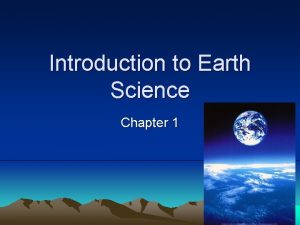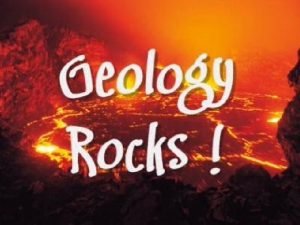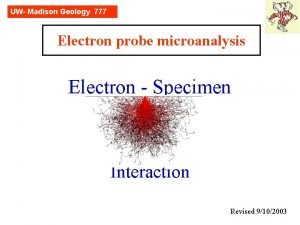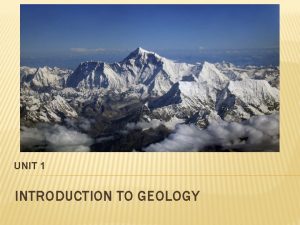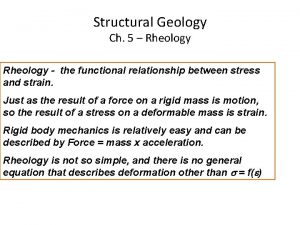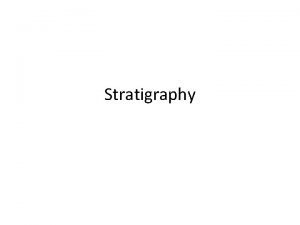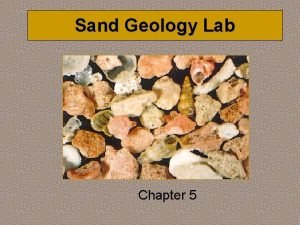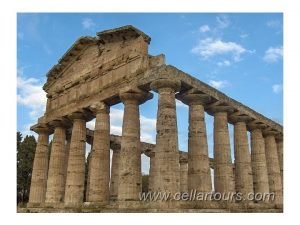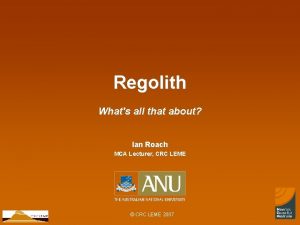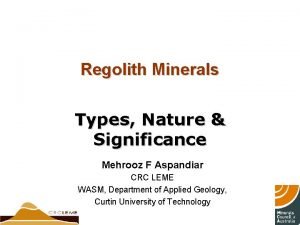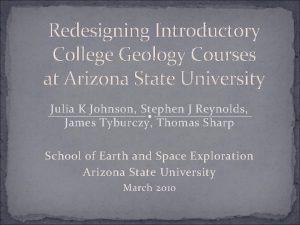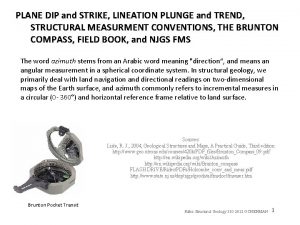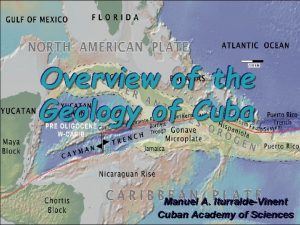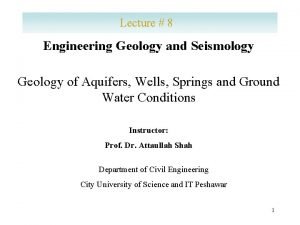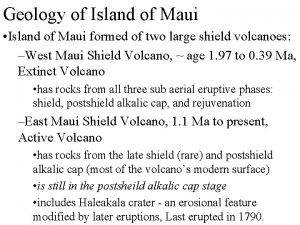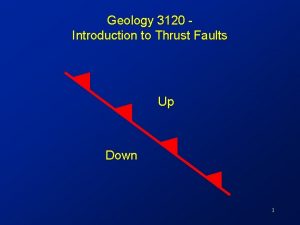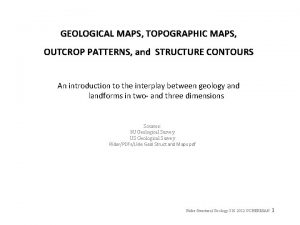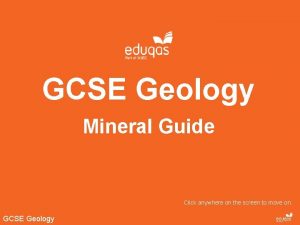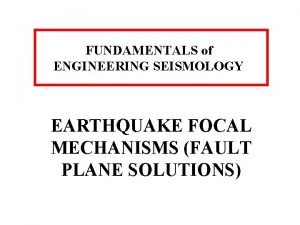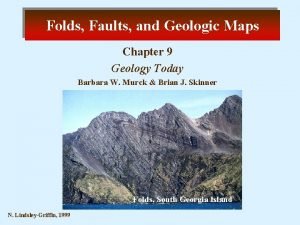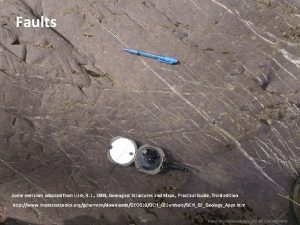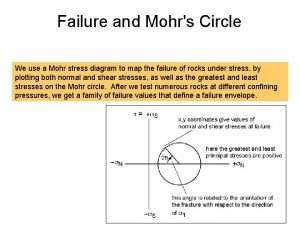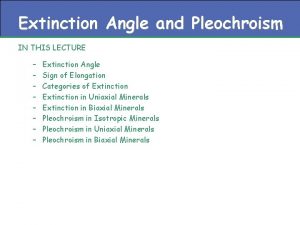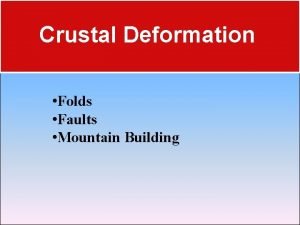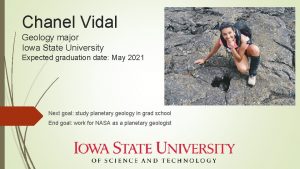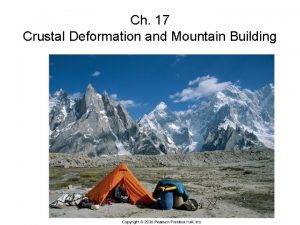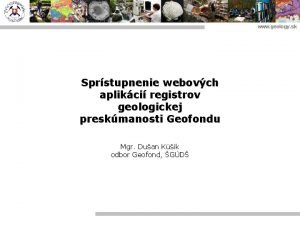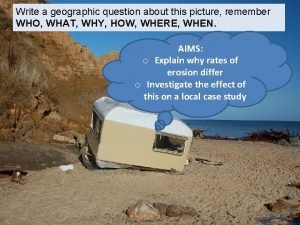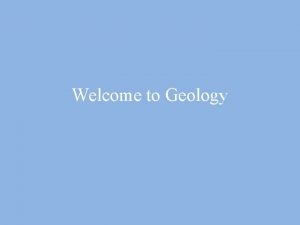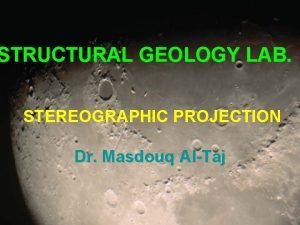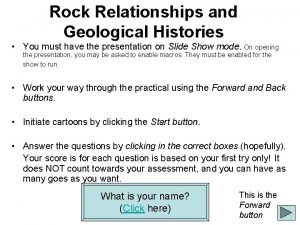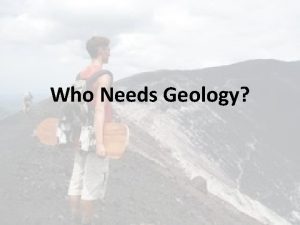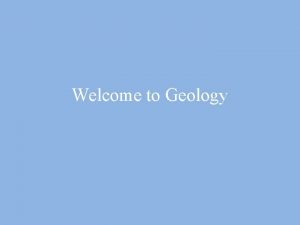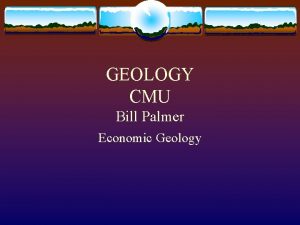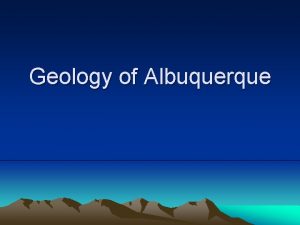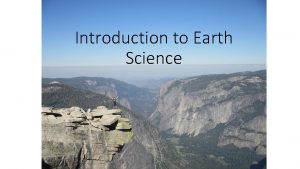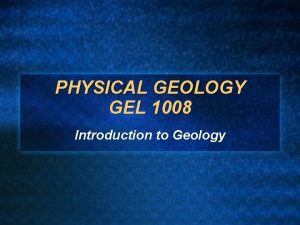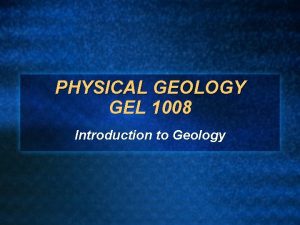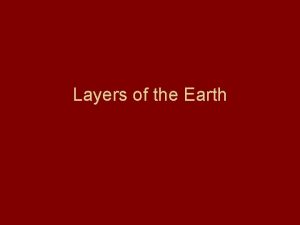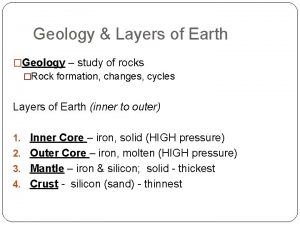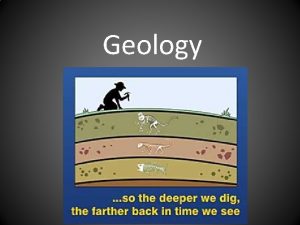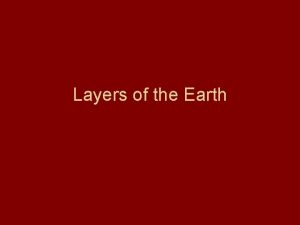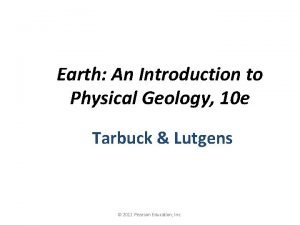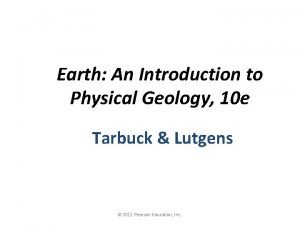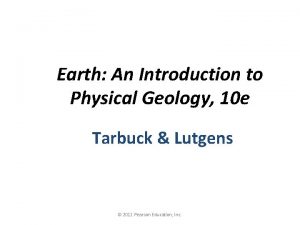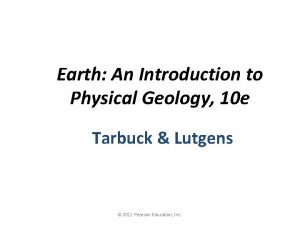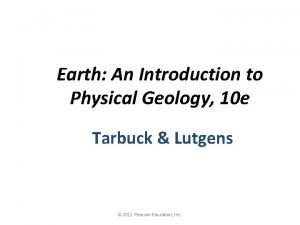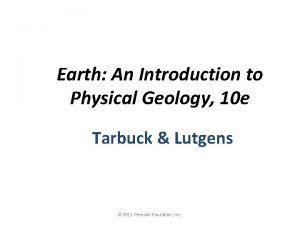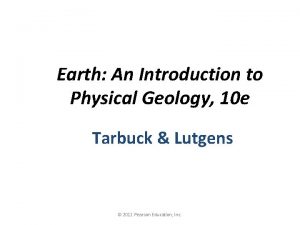Earth An Introduction to Physical Geology 10 e

















































- Slides: 49

Earth: An Introduction to Physical Geology, 10 e Tarbuck & Lutgens © 2011 Pearson Education, Inc.

Metamorphism and Metamorphic Rocks Earth, 10 e - Chapter 8 Stan Hatfield Southwestern Illinois College © 2011 Pearson Education, Inc.

Metamorphism • Transition of one rock into another by temperatures and/or pressures unlike those in which it formed • Metamorphic rocks are produced from: • Igneous rocks • Sedimentary rocks • Other metamorphic rocks © 2011 Pearson Education, Inc.

Metamorphism • Metamorphism progresses incrementally from low grade to high grade. • During metamorphism, the rock must remain essentially solid. • Metamorphic settings • Contact or thermal metamorphism—driven by a rise in temperature within the host rock © 2011 Pearson Education, Inc.

Metamorphism • Metamorphic settings • Hydrothermal metamorphism—chemical alterations from hot, ion-rich water • Regional metamorphism – Occurs during mountain building – Produces the greatest volume of metamorphic rock – Rocks usually display zones of contact and/or hydrothermal metamorphism. © 2011 Pearson Education, Inc.

Agents of Metamorphism • Heat • Most important agent • Recrystallization results in new, stable minerals. • Two sources of heat: 1. Contact metamorphism—heat from magma 2. An increase in temperature with depth— geothermal gradient © 2011 Pearson Education, Inc.

Agents of Metamorphism • Pressure and differential stress • Increases with depth • Confining pressure applies forces equally in all directions. • Rocks may also be subjected to differential stress, which is unequal in different directions. © 2011 Pearson Education, Inc.

Pressure in Metamorphism © 2011 Pearson Education, Inc.

Agents of Metamorphism • Chemically active fluids • Mainly water • Enhances migration of ions • Aids in recrystallization of existing minerals © 2011 Pearson Education, Inc.

Agents of Metamorphism • Chemically active fluids • Sources of fluids – Pore spaces of sedimentary rocks – Fractures in igneous rocks – Hydrated minerals such as clays and micas © 2011 Pearson Education, Inc.

Agents of Metamorphism • The importance of parent rock • Most metamorphic rocks have the same overall chemical composition as the original parent rock. • To a large extent, mineral makeup determines the degree to which each metamorphic agent will cause change. © 2011 Pearson Education, Inc.

Metamorphic Textures • Texture—size, shape, and arrangement of mineral grains • Foliation—any planar arrangement of mineral grains or structural features within a rock • Examples of foliation – Parallel alignment of platy and/or elongated minerals © 2011 Pearson Education, Inc.

Metamorphic Textures • Foliation • Examples of foliation – Parallel alignment of flattened mineral grains and pebbles – Compositional banding – Slaty cleavage where rocks can be easily split into thin, tabular sheets © 2011 Pearson Education, Inc.

Metamorphic Textures • Foliation can form in various ways, including: – Rotation of platy and/or elongated minerals – Recrystallization of minerals in the direction of preferred orientation – Changing the shape of equidimensional grains into elongated shapes that are aligned © 2011 Pearson Education, Inc.

Foliation Resulting from Directed Stress © 2011 Pearson Education, Inc.

Metamorphic Textures • Foliated textures • Rock or slaty cleavage – Closely spaced planar surfaces along which rocks split – Develops in a number of ways © 2011 Pearson Education, Inc.

Slaty Cleavage © 2011 Pearson Education, Inc.

Metamorphic Textures • Foliated textures • Schistosity – Platy minerals are discernible with the unaided eye. – Exhibit a planar or layered structure – Rocks having this texture are referred to as schist. © 2011 Pearson Education, Inc.

Metamorphic Textures • Foliated textures • Gneissic – During higher grades of metamorphism, ion migration results in the segregation of minerals. – Gneissic rocks exhibit a distinctive banded appearance. © 2011 Pearson Education, Inc.

Metamorphic Textures • Other metamorphic textures • Those metamorphic rocks that lack foliation are referred to as nonfoliated. – Develop in environments where deformation is minimal – Typically composed of minerals that exhibit equidimensional crystals • Porphyroblastic textures – Large grains, called porphyroblasts, surrounded by a fine-grained matrix of other minerals © 2011 Pearson Education, Inc.

Common Metamorphic Rocks • Foliated rocks • Slate – Very fine-grained – Excellent rock cleavage – Most often generated from low-grade metamorphism of shale, mudstone, or siltstone © 2011 Pearson Education, Inc.

Common Metamorphic Rocks • Foliated rocks • Phyllite – Gradational between slate and schist – Platy minerals not large enough to be identified with the unaided eye. – Glossy sheen and wavy surfaces – Exhibits rock cleavage – Composed mainly of fine crystals of muscovite and/or chlorite © 2011 Pearson Education, Inc.

Phyllite © 2011 Pearson Education, Inc.

Common Metamorphic Rocks • Foliated rocks • Schist – Medium- to coarse-grained – Platy minerals (mainly micas) predominate – The term schist describes the texture. – To indicate composition, mineral names are used (such as mica schist). © 2011 Pearson Education, Inc.

Mica Schist © 2011 Pearson Education, Inc.

Common Metamorphic Rocks • Foliated rocks • Gneiss – Medium- to coarse-grained – Banded appearance – High-grade metamorphism – Often composed of light-colored, feldspar-rich layers with bands of dark ferromagnesian minerals © 2011 Pearson Education, Inc.

Gneiss © 2011 Pearson Education, Inc.

Classifying Metamorphic Rocks © 2011 Pearson Education, Inc.

Common Metamorphic Rocks • Nonfoliated rocks • Marble – Coarse, crystalline – Parent rock was limestone or dolostone – Composed essentially of calcite or dolomite crystals – Used as a decorative and monument stone – Exhibits a variety of colors © 2011 Pearson Education, Inc.

Marble © 2011 Pearson Education, Inc.

Common Metamorphic Rocks • Nonfoliated rocks • Quartzite – Formed from a parent rock of quartz-rich sandstone – Quartz grains are fused together. © 2011 Pearson Education, Inc.

Quartzite © 2011 Pearson Education, Inc.

Metamorphic Environments • Contact or thermal metamorphism • Result from a rise in temperature when magma invades a host rock • The zone of alteration (aureole) forms in the rock surrounding the magma. • Most easily recognized when it occurs at or near Earth’s surface. © 2011 Pearson Education, Inc.

Contact Metamorphism © 2011 Pearson Education, Inc.

Metamorphic Environments • Hydrothermal metamorphism • Chemical alteration caused when hot, ionrich fluids circulate through fissures and cracks that develop in rock • Most widespread along the axis of the midocean ridge system © 2011 Pearson Education, Inc.

Hydrothermal Metamorphism © 2011 Pearson Education, Inc.

Metamorphic Environments • Regional metamorphism • Produces the greatest quantity of metamorphic rock • Associated with mountain building © 2011 Pearson Education, Inc.

Regional Metamorphism © 2011 Pearson Education, Inc.

Metamorphic Environments • Other metamorphic environments • Burial metamorphism – Associated with very thick sedimentary strata – Required depth varies depending on the prevailing geothermal gradient. • Metamorphism along fault zones – Occurs at depth and high temperatures – Pre-existing minerals deform by ductile flow. © 2011 Pearson Education, Inc.

Metamorphism Along a Fault Zone © 2011 Pearson Education, Inc.

Metamorphic Environments • Other metamorphic environments • Impact metamorphism – Occurs when high-speed projectiles, called meteorites, strike Earth’s surface – Rocks are called impactiles. © 2011 Pearson Education, Inc.

Metamorphic Zones • Systematic variations in the mineralogy and textures of metamorphic rocks are related to the variations in the degree of metamorphism. • Index minerals and metamorphic grade • Changes in mineralogy occur from regions of low-grade metamorphism to regions of highgrade metamorphism. © 2011 Pearson Education, Inc.

Metamorphic Zones • Index minerals and metamorphic grade • Certain minerals, called index minerals, are good indicators of the metamorphic conditions in which they form. • Migmatites – Highest grades of metamorphism that is transitional to igneous rocks • Facies – Metamorphic rocks that contain the same assemblage of minerals © 2011 Pearson Education, Inc.

Metamorphic Zones in New England © 2011 Pearson Education, Inc.

Metamorphism and Plate Tectonics • Most metamorphism occurs along convergent plate boundaries • Compressional stresses deform the edges of the plate. • Formation of Earth’s major mountain belts, including the Alps, the Himalayas, and the Appalachians © 2011 Pearson Education, Inc.

Metamorphism and Plate Tectonics • Large-scale metamorphism also occurs along subduction zones at convergent boundaries. • Several metamorphic environments exist here. • Important site of magma generation © 2011 Pearson Education, Inc.

Metamorphism and Plate Tectonics • Metamorphism at subduction zones • Mountainous terrains along subduction zones exhibit distinct linear belts of metamorphic rocks. – High-pressure, low-temperature zones nearest the trench – High-temperature, low-pressure zones further inland in the region of igneous activity © 2011 Pearson Education, Inc.

Metamorphic Facies and Plate Tectonics © 2011 Pearson Education, Inc.

End of Chapter 8 © 2011 Pearson Education, Inc.
 Geology earth science definition
Geology earth science definition Geology earth science definition
Geology earth science definition Earth science vs geology
Earth science vs geology Earth science branches
Earth science branches Define physical geology
Define physical geology Introduction to geology ppt
Introduction to geology ppt Different layers of earth
Different layers of earth The outer core is made up of
The outer core is made up of What are earth's physical layers
What are earth's physical layers 2 types of earth's crust
2 types of earth's crust Earth physical features
Earth physical features Earth's physical geography chapter 2
Earth's physical geography chapter 2 Study of the earth's physical features
Study of the earth's physical features Lesson 1: introduction to the earth
Lesson 1: introduction to the earth Chapter 1 introduction to earth science
Chapter 1 introduction to earth science Introduction to earth science
Introduction to earth science What is geology
What is geology Uw
Uw What is geology?
What is geology? Structural geology
Structural geology Types of folds geology
Types of folds geology Geology lecture series
Geology lecture series Grain size card
Grain size card Types of differential stress
Types of differential stress What is regolith in soil
What is regolith in soil Mineral council australia
Mineral council australia Arizona state university geology
Arizona state university geology Trend plunge dip dip direction
Trend plunge dip dip direction Geology of cuba:
Geology of cuba: Confined and unconfined aquifer
Confined and unconfined aquifer Maui elevation
Maui elevation Thrust geology
Thrust geology Outcrop patterns geology
Outcrop patterns geology Gcse geology data sheet
Gcse geology data sheet Gcse geology
Gcse geology Beach ball seismology
Beach ball seismology Osk
Osk Structural geology practical exercises
Structural geology practical exercises Mohr's circle
Mohr's circle Extinction angle
Extinction angle Department of geology university of dhaka
Department of geology university of dhaka Types of folds geology
Types of folds geology Chanel vidal
Chanel vidal Reverse fault
Reverse fault Eduqas a level geology past papers
Eduqas a level geology past papers Www.geology.sk
Www.geology.sk Geology map of holderness coast
Geology map of holderness coast Geology vocabulary
Geology vocabulary Orthographic projection geology
Orthographic projection geology Conformable contact geology
Conformable contact geology
